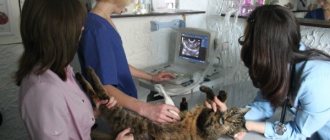Factors affecting lifespan
- Heredity. Labradors are prone to genetic diseases: joint dysplasia, epilepsy, retinal atrophy, psoriasis, diabetes. To minimize the risk of acquiring a genetically unhealthy animal, a puppy is purchased from a breeder with documents.
- Conditions of detention. The breed is adapted to walks at sub-zero temperatures, but is not intended for living in an enclosure or wintering outside. An animal can catch a cold if it sleeps on a cold floor, snow or frost. Labrador is a pet for pets. There is a risk of catching a cold even in an apartment if the dog sleeps in a draft.
- Gender differences. Females live longer than males. But the body of bitches wears out after each birth of puppies. Dog handlers say that with proper care, dogs live the same number of years, regardless of gender.
- Castration, sterilization. Unoperated individuals have an increased risk of diseases - prostatitis in males, oncology in females. The use of hormonal drugs does not solve this issue.
- Food quality. The breed is prone to food allergies, gastritis, dermatitis, urolithiasis and many others that come from poor nutrition. When using high-quality food or natural food (meat, cereal, cottage cheese), the animal will live longer than when eating leftovers from the owner’s table or cheap food.
- Physical activity. If you don’t exercise your dog, don’t provide him with long active walks, jumping and games, the risk of your pet becoming obese is high. This creates extra stress on the heart and joints of the body.
Compared to other large breeds, the Labrador Retriever lives a long time. This is a good-natured, smart and beautiful dog. Before getting a representative of the breed, it is advisable to familiarize yourself with the specifics of its maintenance in order to understand whether the owner can provide the pet with the necessary care.
How to extend lifespan
In order for a pet to please its owner with its presence in their life for as long as possible, it is necessary to create all the necessary conditions for it. The quality and life expectancy of these dogs can be significantly improved if you follow simple rules:
- Vaccination. The dog needs to be vaccinated, which will protect it from many fatal diseases.
- Regular walking. A Labrador should be outside 2-3 times a day and walks should not be short. Time outside with such a dog should be spent actively, playing sports or simply playing with a ball or a stick.
- Visit doctor. You should take your dog to the vet not only if there are any symptoms of illness.
- Proper feeding. The nutrition of a Labrador must be taken seriously. Particular attention should be paid to the diet of dogs that are already 7-8 years old.
- Care. Brushing, washing, cleaning ears, eyes and teeth, as well as trimming nails, should be done regularly and efficiently.
How the owner treats his pet will play a major role in his life expectancy. A Labrador who sits on a chain, eats scraps and has never seen a veterinarian is unlikely to live to be 5, or even 4 years old.
Similar articles
How to increase your life expectancy
A person is required to love, care and be attentive to a pet.
Take the Attention Test! Find 10 differences! (click right here!)
Find the answer Are you bothered by some problem or question? Enter “Breed” or “Name of the problem” into the form, press Enter and you will find out everything about the issue that interests you.
What specific measures and habits should the owner cultivate in himself:
- Monitor the animal's diet. It is important to calculate the norm per kg of weight and not exceed. It would be wrong to rely on the dog’s desire; it may eat more than it needs. When overeating, Labradors develop obesity, diabetes, and skeletal problems.
- Regular medical examination. This includes annual vaccinations, treating the animal against ticks, fleas and parasites. It is important to carry out castration or sterilization surgery at the right time if the goal is not to breed puppies.
- Be attentive to appearance. A healthy dog has shiny fur, white teeth, and high motor activity.
- Walk on a leash in unfamiliar places. Firstly, so that the naturally curious Labrador does not run away to explore the area. Secondly, to avoid poisoning the animal.
- Training. Important for the safety of the retriever and for establishing a bond between dog and owner.
- Ensure normal walking. It is important for your pet not just to walk around the house, but to play, run and jump.
- Monitor the emotional background of the animal. Stress will not harm your dog, but it can cause illness. There are cases where, when a child was born in a family, a Labrador Retriever developed cataracts or diabetes. The dog is not able to cope with decreased attention, so it is recommended to get a retriever in families where there are already children. It is important to play with your pet, brush its fur, show love, and not be separated for long.
Good care and concern from the owner will prolong the life of the pet. When purchasing a Labrador for your home, remember that how long the animal will live depends on its human.
Comparison of the ages of Labradors and humans
10-14 years allotted for a pet, in the understanding of many owners, is negligible. But you shouldn’t equate the lifespan of a dog with the lifespan of a human. The fact is that the body of almost all domestic animals wears out quickly, and already at the age of 8-9 years old age sets in for doggies. To make it clearer, let’s present a table comparing the ages of dogs and humans:
Based on the data in the table compiled by dog handlers who correlated the state of the dog’s body with that of a human, we can conclude: 14 years is not so little. Moreover, there is a possibility that a pet with good care and excellent health can last a little longer - up to 15-16 years (87-89 years by human standards).
Causes of premature death of a dog
Accidents, poisoning, and existing pathologies of internal organs lead to the sudden death of animals. Negative consequences are difficult to predict, however, it is preferable to know what potential dangers threaten your pet.
Common causes of premature canine death:
- poisoning;
- heart disease;
- pneumothorax;
- tracheal collapse;
- congenital abnormalities;
- expansion, volvulus of the stomach;
- ulcer;
- splenic tumor rupture;
- foreign body entering the throat;
- heatstroke;
- injury.
Dogs often suffer from poisons intended for rodents, poisons distributed to exterminate stray dogs. During a walk, be sure to keep an eye on your pet; if the dog does not respond to the command “ugh,” put on a closed muzzle so that the dog does not try questionable “food.”
Heart diseases can manifest asymptomatically, but if a young dog gets tired quickly, is weak, or is breathing heavily, you need to visit a veterinarian for a diagnostic examination.
Air accumulation in the peripulmonary space (pneumothorax) occurs due to injuries to the sternum leading to damage to the emphysematous bladder or existing tumor on the lung.
Tracheal collapse is more common in small breeds, is expressed by a sharp cough after active mobility or the manifestation of strong emotions, and sometimes occurs as a complication of past infections.
A congenital pathology that leads to tragic consequences is the displacement of the cervical vertebrae as a result of insufficient development or defect of the ligaments. An accidental jolt to the problem area can cause pressure on the spinal cord and be fatal.
Gastric dilatation and volvulus are more common in older dogs; both pathologies interfere with the normal blood supply to other organs and are considered deadly. Prevention of stomach problems is considered to be proper nutrition, adherence to a feeding regime and moderate exercise.
The premature death of the animal is caused by complications of peptic ulcer disease, expressed in the formation of a through hole in the wall of the stomach or bleeding. A precaution is the proper nutrition of your pet.
New growths on the spleen (benign and malignant) are susceptible to rupture, which can lead to fatal loss of blood. Tumor rupture is possible even with minor damage caused by difficult bowel movements or increased physical activity.
Swallowing a foreign object risks suffocation or injury to internal organs as the swallowed object moves inside.
Heatstroke is caused by severe overheating of the body and often occurs in dogs locked in a car in hot weather.
A dog can be injured on the street (being hit by a car, fighting with other dogs, etc.), at home (falling from a height, electric shock, etc.), the danger of injury depends on the degree of its severity and the provision of first aid.
How to help your Labrador live a long life
From all of the above, we can conclude: to help your tailed Labrador friend live in this world as long as possible, you need to:
- Keep an eye on your dog while walking
(and there is not only the danger of the roads, but also encounters with stray packs of dogs, and the risk of poisoning). It is extremely important that the dog knows commands and obeys the owner; - Feed your pet correctly, eliminating all questionable foods from the menu.
Plus, it’s important to make sure your dog doesn’t overeat. You can always consult a veterinarian about your diet; - For a preventive examination, take your dog to a specialist at least once a year.
And urgently contact a veterinarian, regardless of the time of day, if the dog is unwell (high temperature, diarrhea, vomiting, convulsions, etc.). All doctor’s instructions must be followed strictly; - Don't forget about vaccinations
, most of which need to be given to your dog annually; - Eliminate ticks, fleas, lice, lice and worms.
Or carry out preventive measures to prevent such parasitic infestations; - If the Labrador lives outside, make sure that the dog does not catch a cold
(insulate the booth, cover the floor of the enclosure with wood, on very cold days it is better to invite the animal into the house); - Communicate with your Labrador every day
, involving all family members in games; - Take the dog for daily walks
(twice or three times a day for 40 minutes or more), travel together, forays into nature, bike rides; - Castrate or sterilize the animal
if your plans do not include breeding puppies.
Good-natured Labrador retrievers have long won first place in the top of the most intelligent, useful and hardy dogs. But you can't argue with nature. Often, a dog’s health is undermined by severe genetic diseases and other factors that shorten the pet’s lifespan. So how long do Labradors live?
Caring for an older dog
At home, an elderly pet should be provided with:
- balanced food, following the feeding regimen;
- monitoring the animal’s body weight and well-being;
- maintaining hygiene (grooming, cleaning the mouth, eyes, ears, trimming nails);
- prevention against parasites;
- moderate physical activity.
Regular preventive examinations of the dog at the veterinarian will help identify diseases and age-related changes in the body, promptly take appropriate measures to treat emerging diseases and alleviate the pet’s condition.
Owner reviews
Despite all the advantages of such animals, the opinions of dog breeders about them are ambiguous. Retriever owners note that this is an allergenic breed. They confirm the need to carefully care for your pet’s coat, bathe the dog often, and clean the house so that family members do not have problems with it. At the same time, many owners of retrievers claim that such animals have a gentle disposition, get along well with children, and easily master various commands. With proper upbringing, there are no problems with them.
Dog breeders also recommend that everyone who wants to have a boy or girl of a similar breed first think about where the animal will live, whether it will participate in mating, where it will be kept during vacation, and find out how much it costs to maintain a pet. If all these issues are resolved in advance, life with a retriever will be easy and carefree.
The Labrador is a dog of medium height and heavy build.
Distinctive features are a large head, powerful paws, a strong neck and a wide chest.
Height at withers – 50-57 cm, weight 30-40 kg, life expectancy 13-15 years.
The dog has a soft and good-natured character, loves children and takes other pets well.
Labradors are very sociable, intelligent, and easily adapt to their owner’s mood.
Expert opinion Semyon Kirillovich Kozhevin Expert dog handler Read more Did your dog chew your new shoes or eat your children's toy? Stealing food from the table or picking up trash on the street? Ignores you and snaps at other family members, refusing to follow commands? ProDog School presents a unique online course on training dogs of all breeds and ages, developed by a dog handler with 30 years of experience!
- 20 video lessons (average duration 20-30 minutes), 80% of this time is practice;
- PDF notes for each lesson, with them it is easy to practice training in any convenient place;
- Unlimited help from a professional dog handler - answers to your questions about the course in the comments to the lessons;
- Bonus lessons and materials for teaching your dog tricks.
Before answering this question, it should be said that a Labrador is not a dog for which life in an enclosure or kennel is the norm.
The dog's body is not adapted to cold winters and bad weather.
This means that living outdoors will negatively affect your pet’s health. Also important are the attitude towards the dog, the quality of food, timely examination by a veterinarian, and so on.
Statistics say that the life expectancy of a Labrador living on the street will be no more than 10 years.
Expert opinion Semyon Kirillovich Kozhevin Expert dog handler. Ask a question to an expert “Labradors are generally energetic, active dogs that need regular walks and exercise. Otherwise, they develop heart problems, arthritis, and excess weight. And this can seriously affect the pet's life expectancy. With proper care and good conditions, the life expectancy of a Labrador can reach up to 15 years.”
Factors influencing lifespan
The life expectancy of dogs is influenced by factors:
- Physical development;
- Does the animal perform loads appropriate for its age and breed;
- Complete rest;
- A balanced diet enriched with nutrients;
- Sufficient communication and attention.
All these quality indicators of life depend 100% on the owner. The way he takes care of his pet shapes the animal’s resistance to stress and various diseases.
A balanced diet from birth lays the foundation for the pet’s physical health for the rest of its life and even into old age. An older dog should be fed soft food to avoid problems with teeth and swallowing.
In old age, animals can suffer from various diseases, most often deteriorating hearing, vision, and disruptions in the urinary system.
Another problem that can significantly reduce the age of any animal is excess weight. Its excess has a bad effect on the pet’s health, affecting the cardiovascular system and bone structure. It is necessary to control the weight of the animal, especially in old age.
Regular medical examinations, vaccinations, timely contacting a veterinary clinic in case of problems - this is what will keep your pet in the right shape. Constantly caring for your pet throughout its life can significantly increase its cycle.
How to determine age
The age of a dog is determined by its teeth. On the 25th day, the puppy begins to develop milk teeth, which are replaced by permanent teeth at 3-4 months. In one year, the dentition is completely formed.
Fawn Labrador Puppy
In older dogs, the lobes on the front incisors are worn away, resembling a trefoil corolla; this usually occurs by the age of 2 years. In dogs older than 3 years, the teeth become yellow and dull. 5-year-old dogs' fangs become dull. A 10-year-old dog's teeth are completely yellow, with worn incisors and canines, and are falling out in places.
For your information! Another sign of determining the age of a Labrador is gray hair on the face, which appears after 6-7 years. The eyes of older dogs become cloudy and sunken.
Elderly Labrador
How long do purebred animals live?
According to veterinary experts, there is a clear relationship between the breed and the years measured to the animal. It has been scientifically proven that the smaller the dog, the longer its life.
The vitality of representatives of different breeds varies. This is due to human breeding activities. When developing standards, dogs develop and reinforce features that are often unnatural.
Breeding a breed is fraught with complications, which are expressed in hereditary diseases:
- Chihuahua. These cute little creatures are genetically prone to medial dislocations of the kneecaps, elbow joints, and various dysplasias.
- Dachshund. Natural hunters, with a funny long body on short legs, pay with health for such a body structure. Hereditary pathology in dachshunds is intervertebral disc disease.
- Shar-Pei. Not only in this breed of dog, but in all pets with skin folds, the disease entropion, which is essentially an entropion of the eyelid, is common.
- Rottweilers. Strong, brave, fearless, smart. But they are also susceptible to hereditary diseases - aortic stenosis, Rottweiler leukoencephalopathy, follicular lipidosis.
- Pikines. This ancient breed is distinguished by a special eye structure, for which it suffers from a tendency to eversion of the eyelids, cataracts, and corneal ulcers.
Each breed has its own Achilles heel - dogs with flat faces have problems with the respiratory system, with skin without fur - they suffer from allergies, large pets are often diagnosed with diseases of the joints and bones.
Breeders allow for different situations that affect the life expectancy of dogs:
- Inbreeding;
- Exclusion of the factor of natural selection;
- The appearance of the offspring becomes a priority, not health;
- The lifespan of the progenitors of the offspring is not taken into account.
Dogs of breeds that are less susceptible to selection changes, of medium size, without any special appearance, live the longest. These are terriers, shepherds, huskies.
The presence of long-livers in the family is of great importance. If the pet's parents lived to a ripe old age, then it has every chance of a long life. If we talk about numbers, on average, dogs live about 12 years.
Hereditary diseases
Retrievers are genetically prone to the following diseases:
- Dermatitis. A long-haired pet can pick it up during active shedding.
- Inflammation of the eyes. To prevent its development, owners need to regularly examine the dog’s eyes and rinse them with chamomile decoction when the first signs of inflammation appear.
- Dental stones. They need to be removed periodically.
- Gastrointestinal disorders. Retrievers are prone to food allergies. A dog with this disease is apathetic and does not eat well. To avoid the development of such pathologies, the animal needs to be provided with proper, regular feeding of proven products.
- Helminthiasis, which a dog can pick up from other animals. To prevent this disease, it is enough to deworm the animal twice a year.
Dogs are not genetically prone to other pathologies. But they can appear if owners do not properly care for the puppy and ignore the veterinarian's recommendations.
Osteochondrosis
Osteochondrosis is a thickening of the cartilage covering the bones. It most often occurs in puppies between 5 and 18 months of age, and is more common in males than females. The causes of thickening of cartilage are not precisely known, but there are suggestions that osteochondrosis in Labradors may be caused by poor nutrition, rapid growth, or genetic predisposition.
Most often, osteochondrosis affects the hock, shoulder and knee joints. With the development of osteochondrosis, the cartilage becomes fragile and peels off when injured - OCD is formed - osteochondritis dissecans, as a result of which the puppy begins to limp and suffer from joint pain. Another consequence of osteochondrosis in Labradors is an increased risk of later developing arthritis.
The disease is treated with both surgical and conservative methods - painkillers, joint lubricants and restriction of physical activity. There is still debate about what is more effective - surgery or conservative treatment. Some veterinarians are confident that timely surgery helps to significantly reduce the risk of developing arthritis. Others are convinced that conservative treatment is no less effective, but safer. In any case, it is up to the dog owner to decide.
Description and character
Individuals of this breed have an amazing appearance. They are well built, have a proportional, good build, and powerful body. Dogs have straight, powerful limbs, paws - large, rounded. The movements of the representatives of the breed are active, swift, the dogs run very easily, without spending an excessive amount of energy.
The main decoration that a Golden Retriever dog has is its fur. It can be straight or slightly wavy, cream or golden in color. The presence of a waterproof, dense undercoat is necessary for the animal to hunt on water.
Today, individuals of this breed are actively used not only as hunters. The main qualities of the animal include:
- fast reaction;
- determination;
- friendliness;
- peacefulness.
All this makes it possible to use the dog as a rescuer to search for explosives or narcotic substances. Also, these animals are excellent guides for blind people and excellent helpers for people with disabilities. These pets can be kept both in a house and in an apartment.
Before answering the question of how long golden retrievers live, it is necessary to note that these dogs are excellent hunters who can show all their qualities in any terrain. Having an excellent sense of smell, representatives of the breed bring game to the owner. In particular, this animal is indispensable when hunting waterfowl.
In individuals of this breed, the character at an early age can be characterized by disobedience. However, good training and owner responsibility can easily eliminate this deficiency. If the dog does not throw out the accumulated energy, then he will direct it to spoiling furniture and other property in the house.
A well-mannered dog is an affectionate and gentle dog. He is very playful and at the same time calm, not prone to dominance, for this reason he is friendly towards other pets. Representatives of the breed are very intelligent and delicate, they completely lack aggression, for this reason they can be owned by families with small children.
Video
Among the representatives of the Labrador Retriever breed there are many long-lived people. The lifespan of a dog depends on many factors. However, the life of a four-legged friend is in the hands of a caring owner. Taking care of health, proper maintenance and attention is the key to a happy and long life for a pet (video from the CatPes channel).
The most popular dogs around the world, these sunny dogs are ideal and reliable companions. A magnificent golden retriever, whose breed description indicates the presence of a large number of positive qualities of the animal, is truly capable of bringing a sea of joy and happiness to the house.
What is the average life expectancy of a Labrador?
The Labrador Retriever is a large breed of dog. As you know, the lifespan of large purebred animals rarely exceeds 12 years. Thus, the life expectancy of Labradors is on average 10-12 years. However, there are cases when these dogs lived up to 15 and even 18 years.
The most famous long-livers of this breed are the Labrador Adjutant (Great Britain) who lived 27 years and 98 days, as well as a cross between the Labrador and the Australian shepherd Chilla - 32 years.
Obviously, many factors influence a dog's lifespan.










